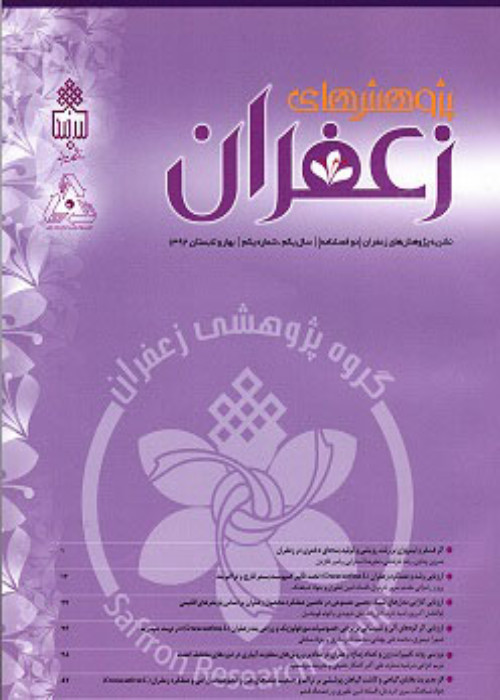Effects of Irrigation Water Quality, Bio-fertilizer and Nanoparticles of Fe on Yield and Some Physiological Traits of Saffron (Crocus sativus L.)
Nutrition management in saffron cultivation is one of the important issues in the production of this valuable product. Studies have shown that the use of bio-fertilizers and nano-fertilizers can be effective in reducing the inhibitory effects of drought and salinity stress. Also nano-fertilizers have high consumption efficiency and can optimally release their nutrients at a suitable point in the root growth area. The tendency of saffron to grow in a dry climate has caused the cultivation of this plant to expand in the eastern lands of the country. Meanwhile, the lands in the east of the country often face drought and salinity problems due to low and scattered rainfall. Thus, present study was performed to investigate the effects of salinity levels, bio-fertilizer and nano-fertilizer of Fe on yield and physiological characteristics of saffron.
Present study was performed in a farm that located in Torbat Heydarieh city, in 2018-2019. The experiment was conducted as factorial layout based on a randomized complete block design with three replications and analyzed by combined analysis in location (salinity). Bio-fertilizer was applied at four levels of zero, 500, 1000 and 1500 kg ha-1 and nano particles of Fe was applied at two levels of non-used and application of four liters per hectare. These factors were investigated in two locations with different irrigation salinity (2.29 and 4.49 dS m-1).
The results showed that there was the highest value for dry weight of stigma in irrigation conditions with salinity of 2.29 dS m-1. In this trait, under the conditions of irrigation with salinity of 2.29 dS m-1, there was no significant difference between the application and non-application levels of nano-fertilizer of Fe; However, in the conditions of irrigation with salinity of 4.49 dS m-1, the application of nano-fertilizer of Fe compared to non-application, caused a significant increase of 32.8% for dry weight of stigma. Comparison of mean for triple interaction showed that in irrigation conditions with salinity of 4.49 dS m-1 and in all levels of bio-fertilizer, the application of nano-fertilizer of Fe compared to control increased the amount of chlorophyll b and RWC, significantly. At both salinity levels of 2.29 and 4.49 dS m-1, by increasing amounts of bio-fertilizer, the amount of carotenoids significantly increased. Also, at both salinity levels of 2.29 and 4.49 dS m-1 and all levels of bio-fertilizer, the application of Fe nano-fertilizer significantly increased carotenoids compared to conditions of non-application. In irrigation conditions with salinity of 4.49 dS m-1 and at levels of zero and 500 kg ha-1 of bio-fertilizer, the application of Fe nano-fertilizer prevented increasing of proline, significantly and prevented the occurrence of more electrolyte leakage.
In the present research, increasing the salinity from 2.29 to 4.49 dS m-1 caused a significant decrease in dry weight of saffron stigma. However, in the conditions of applying irrigation with a salinity of 4.49 dS m-1, the application of iron nano-fertilizer caused a significant increase in dry weight of stigma compared to its non-application. With increasing amounts of bio-fertilizer in both irrigation conditions, the amount of chlorophyll a also increased. In addition, in irrigation conditions with a salinity of 49.4 dS m-1 and at all levels of bio-fertilizer, the application of iron nano-fertilizer significantly increased the amount of chlorophyll b and RWC, compared to the conditions without its application. Also, in irrigation conditions with salinity of 4.49 dS m-1 and at the levels of zero and 500 kg ha-1 of bio-fertilizer, the application of iron nano-fertilizer significantly prevented the increase of proline and in the same conditions and at all levels of bio-fertilizer, it prevented to do more electrolytes leakage. Based on these results, in order to achieve higher yields in saffron cultivation, irrigation with less saline water is recommended and in case of irrigation with salinity of more than 4.2 dS m-1 in saffron cultivation, the use of iron and bio-fertilizers is recommended to improve the physiological characteristics.
- حق عضویت دریافتی صرف حمایت از نشریات عضو و نگهداری، تکمیل و توسعه مگیران میشود.
- پرداخت حق اشتراک و دانلود مقالات اجازه بازنشر آن در سایر رسانههای چاپی و دیجیتال را به کاربر نمیدهد.





